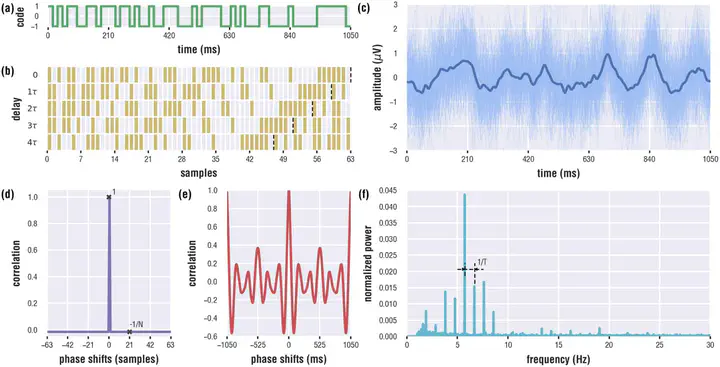Stimulus characteristics of c-VEP BCI

Context
A brain-computer interface (BCI) has the capability to utilize a diverse array of control signals decoded from measured electroencephalogram (EEG) data. One notably effective control signal for achieving both accuracy and speed in BCI performance, particularly in communication and control applications, is the code-modulated visual evoked potential (c-VEP). This signal is generated in response to a pseudo-random sequence of flashes, typically transitioning from a black to a white background on a screen. The selection of pseudo-random sequences often draws inspiration from the telecommunication domain due to their desirable properties, such as low auto- or cross-correlation between different sequences, presumed to evoke distinct brain activities.
Despite the success of c-VEP BCIs, there remains a limited understanding of various stimulus characteristics, how they affect the neural responses, and how they influence decoding performance and user comfort. These characteristics encompass for instance (1) the presentation rate, with faster sequences potentially reducing fatigue and shortening trials, thereby accelerating BCI operation. (2) The choice of colors is another critical consideration, as the conventional black and white, offering maximum contrast and performance, may compromise comfort. Alternative colors (e.g., gray values reducing contrast) might engage different visual pathways, potentially mitigating visual fatigue. (3) Additionally, the stimulus need not be confined to colors but can include diverse alternating images, such as checkerboards, faces, grid stimuli, or motion. (4) Furthermore, optimizing the stimulus sequence, including the timing of flashes, holds potential for maximizing decoding performance and user comfort. (5) Lastly, while binary sequences are predominant, exploring non-binary sequences like quintary m-sequences representing gray-scale values presents a promising avenue for future exploration in enhancing BCI functionality. Moreover, even fully random sequences could be used, as they have shown high performance and improved user comfort.
Image credit: Martínez-Cagigal, V., Thielen, J., Santamaría-Vázquez, E., Pérez-Velasco, S., Desain, P., & Hornero, R. (2021). Brain–computer interfaces based on code-modulated visual evoked potentials (c-VEP): A literature review. Journal of Neural Engineering.
Research question
This project is dedicated to investigating how modifying specific properties of c-VEP stimuli influences BCI performance and user comfort. The exploration of these property changes opens up exciting possibilities for advancing machine learning algorithms as well. Additionally, post-hoc analyses could scrutinize the neural responses associated with improved or diminished BCI performance. This investigation not only holds the potential to enrich our understanding of BCI dynamics but also provides a unique opportunity to gain fresh insights into vision neuroscience. Specifically, it aims to unveil how the brain responds to visual stimuli, as measured by EEG, facilitating a deeper comprehension of the intricate interplay between stimulus characteristics and neural activity. Such insights might also directly inspire alternative improved stimulus sequences that both optimize BCI performance as well as user comfort.
Skills / background required
- Very proficient in Python
- Proficient in machine learning
- Knowledge/interst in vision neuroscience